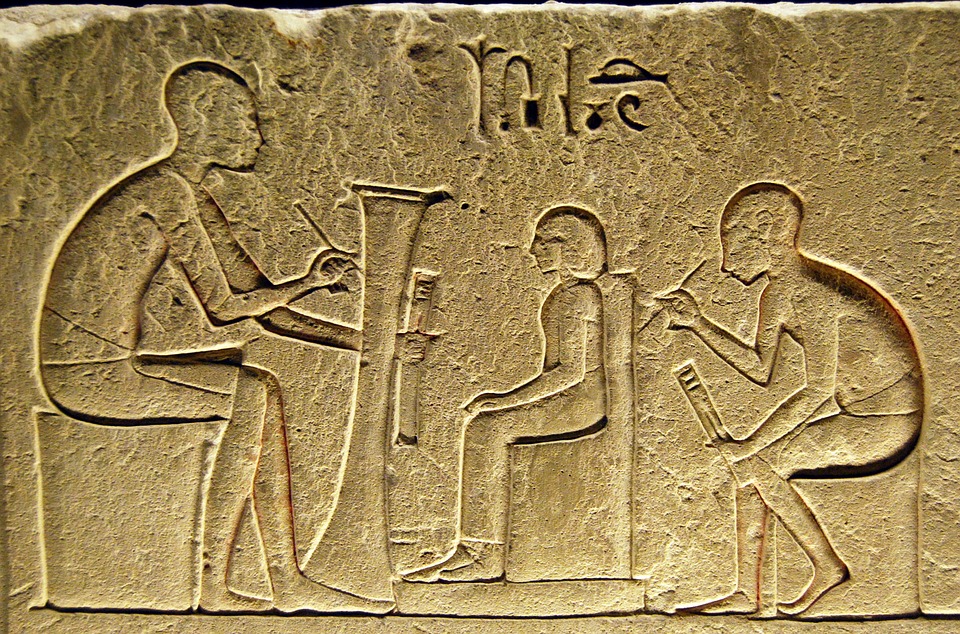
This question started out at the airport. But it started with the Internet search, “pharaoh during Moses’ time.” I’m still wondering what Moses’ time in Egypt was like, and I was surprised that Hatshepsut was mentioned in a possible timeline.
She was included in the article, “Who Were the Egyptian Pharaohs During the Time of Moses?” The article discusses Alfred J Hoerth’s book Archaeology and the Old Testament where he presents an interesting timeline, and Rameses II–a pharaoh usually included in Moses’ story–isn’t that present. Instead, the article talks about the possibility that the pharaoh that eventually let the slaves go was Thutmose III, the stepson/nephew of Hatshepsut.
It’s said Thutmose III was responsible for making Hatshepsut disappear from history.
What I mean by “disappear” is that it was him who tore down her monuments, hid her achievements, and had her pictures scratched out from the wall art.
Back to the airport, I went to YouTube to a Horrible Histories’ sketch I vaguely remember watching about Hatshepsut.
If the video is taken off the Internet, the history you “learn” from it is that Hatshepsut ruled for nearly 22 years, but was probably murdered by her stepson, and then he erased her from history. He was super mad.
It’s a great story, and I love Horrible Histories. But I decided to do a more thorough search.
Well, it was a quick search. My plane was boarding shortly. I scanned some information, and the only information I remembered was she made her stepson head of the army.
I thought about that fact for the whole flight.
Taking a Dig?
So, after I got to my destination and during some free time, I watched a documentary titled Hatshepsut: Secrets of Egypt’s Lost Queen. It’s a about archeologists and other historians examining her life and mummy candidates to see if they could find her.
What stood out to me most was the excitement of those involved in the project. I totally get it. You want to meet a person in history so badly, and this is chance to get close! There were discovered, little trinkets probably owned by Hatshepsut, and I would love to get my hands on something owned my one of my historical heroes!
And of course I was impressed how they narrowed the mummies to one candidate.
If you accept that candidate to be her, then Hatshepsut wasn’t murdered. (Sorry, Horrible Histories.) The documentary reports she died from a tooth infection/disease. Other reports showed diabetes or bone cancer. Whatever the case, she wasn’t killed by someone else.
Then the documentary shifts to a team also looking at certain wall art where they discovered where her images had been. But the images had been scratched away, and they had been replaced with images of Amenhotep II, who happened to be the son of Thutmose III.
The commentators said this action was probably taken for Amenhotep II to have a stronger claim to the throne, and that the throne is usually passed down from father to son.
Plus, Thutmose III didn’t go on a rampage right after her death to destroy Hatshepsut’s legacy. He removed her from history when he got older. Like two decades later. There’s a good chance that Thutmose III wasn’t taking a dig at his stepmother.
She wasn’t the only ruler carved out of Egyptian history–even men were. It was a strategic move to avoid future conflicts. It is sad, but that’s the way it was.
If the documentary was right in their claims, I’d like to imagine she celebrated when found.
Wrapping It Up
Gathering other information, Hatshepsut prepared her stepson very well to rule. I’ve concluded that Hatshepsut practically gift-wrapped Egypt for him.

Ancient Egypt rulers were unlikely to predict the way good technology that was to come. (I’m always surprised with new tech that comes out myself.) Maybe Thutmose III meant to do a sloppy job. But that’s just a speculation.
I believe Hatshepsut and Thutmose III were more of a team than enemies.
Other Thoughts
In one of Simon Whistler’s videos on Hatshepsut, he reflects on remembering Hatshepsut, and how she was unsure how or if she would be remembered.
In case you didn’t make it through this whole video, Mr. Whistler quotes the female phaoroh saying:
“Now my heart turns this way and that, as I think what the people will say. Those who see my monuments in years to come, and who shall speak of what I have done.”
Hatshepsut
I think Hatshepsut’s story offers hope people who think they’ll be forgotten.
But the forgotten part can be temporary…even if thousands of years go by!